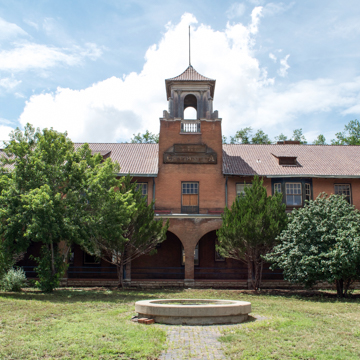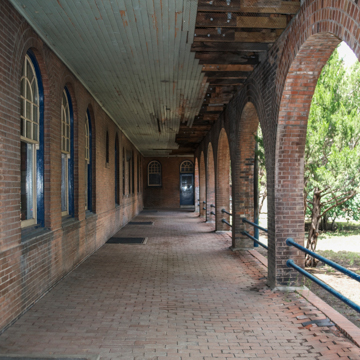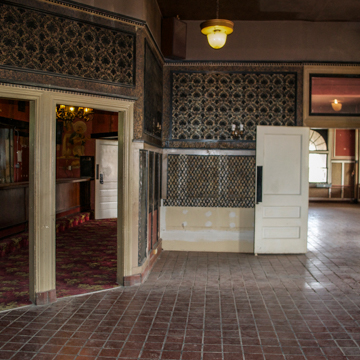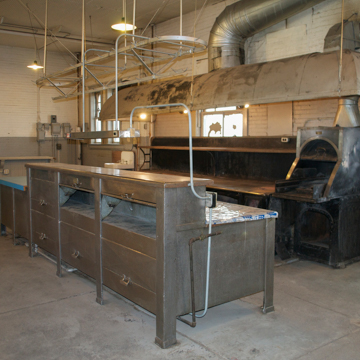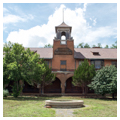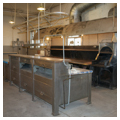The Castañeda Hotel is at once an important surviving example of the Fred Harvey Company hotels and an artifact from the economic heyday of Las Vegas in the late nineteenth century.
Fred Harvey, who immigrated to the United States from England in 1850, revolutionized railroad dining and hospitality when he launched what became the Fred Harvey Houses in the 1870s. Emphasizing high quality cuisine made with locally sourced products, outstanding service, and a comfortable, welcoming atmosphere, the Fred Harvey Houses quickly supplanted the dining stations then located along railway routes. Working in close partnership with the Atchison, Topeka and Santa Fe Railroad, Harvey also helped to foster and define New Mexico’s identity as a tourist destination with a series of hotels that were built by the railroad and managed by Harvey across the Southwest in the late nineteenth and early twentieth centuries. The decision to build the Castañeda Hotel in Las Vegas, four years before the Alvarado Hotel in Albuquerque, recognized the importance of this mercantile and railroad town in territorial New Mexico, before it lost that role to Albuquerque in the first decades of the twentieth century.
The hotel is named for Pedro de Castañeda, the chronicler of Francisco Vasquez de Coronado’s 1540–1541 expedition to New Mexico. Designed by the California architect Frederic Louis Roehrig, the Castañeda Hotel is defined as much by its California Mission style exterior as by the lavish dining and service facilities that dominated the first floor. The U-shaped building embraces an entrance courtyard facing the railroad. Arcaded porticos wrap the brick veneered, wood-framed structure, beneath curvilinear stepped parapets that terminate the two side wings and a bell tower that anchors the central wing; a concrete fountain in the middle of the courtyard completes the effect of a welcoming oasis in the desert.
The adjacent railroad depot is in the same Mission Style, as were the depots in Raton and Albuquerque, and the Alvarado Hotel in Albuquerque (Charles Whittlesey, 1902) and the Chavez Hotel in Vaughn (Myron Church, 1908). In the decades before the Spanish-Pueblo Revival, or Santa Fe Style, emerged as the defining image for New Mexican tourist architecture, the California Mission style was deployed equally by the Fred Harvey Company and by the Atchison, Topeka and Santa Re Railroad to evoke the romance of the Southwest.
Having set the stage, the Mission Style exterior gave way to classical detailing on the interior. As David Gebhard noted, “the Mission image… referred exclusively to a building as an object in the landscape.” Inside, beneath a high pressed tin ceiling and windows that look onto Railroad Avenue, the Castañeda’s first floor dining room is the largest space in the building. Conceived first of all as a dining facility catering to rail passengers, the Castañeda was meant to provide a welcome respite and escape from the wilderness of the surrounding southwestern desert. Double doors lead directly into the kitchen, which retains its original equipment, as does the bakery beyond the kitchen. The Castañeda was also a luxury hotel, with 45 guest rooms on the second floor.
The Castañeda closed in 1948, after the rising popularity of the automobile led to decreased railroad travel. To prevent its demolition, J.J. Lawson of Las Vegas purchased the hotel, converting the upstairs guest rooms into apartments, and altering or updating many of the furnishings, light fixtures, and interior decorations. By 1973, the hotel was in disrepair and the second floor was closed off; only a first floor bar remained in use until the entire building was closed in 1998.
In 2014, Allan Affeldt and Tina Mion, who restored La Posada Hotel in Winslow, Arizona, purchased the hotel with the same intention. Currently closed to the public, the Castañeda is slated to reopen once the restoration is complete.
References
Brooker, Kathleen Ann. “Railroad Depots in New Mexico: Southwestern Styles and the Masonry Tradition. Master's thesis, University of New Mexico, 1981.
Fried, Stephen. Appetite for America: How Visionary Businessman Fred Harvey Built a Railroad Hospitality Empire that Civilized the Wild West. New York: Bantam Books, 2010.
Gebhard, David. “Architectural Imagery, the Mission, and California.” Harvard Architecture Review 1 (Spring 1980); 137-145.
Lynn, Sandra. Windows on the Past: Historic Lodgings of New Mexico.Albuquerque: University of New Mexico Press, 1999.
Harvey, Fred. The Great Southwest along the Santa Fe. Kansas City: F. Harvey, 1914.
Perrigo, Lynn I. “Castañeda Hotel,” New Mexico State Register of Cultural Properties Registration Form. Santa Fe, NM, New Mexico Historic Preservation Division, 1974.
Stiny, Andy. “New Hope for La Castañeda Hotel.” Albuquerque Journal, February 14, 2014.
Stiny, Andy. “New Owner Shows off Historic Las Vegas, NM Hotel.” Albuquerque Journal, April 21, 2014.
Threinen, Ellen. Architecture and Preservation in Las Vegas: A Study of Six Districts. Las Vegas: Design Review Board, City of Las Vegas, New Mexico, 1977.
Threinen, Ellen. “Railroad Avenue Historic District,” New Mexico State Register of Cultural Properties Inventory-Nomination Form. Santa Fe, NM, New Mexico Historic Preservation Division, 1979.
Wilson, Chris (with Anita Vernon and Hilario Romero). Architecture and Preservation in Las Vegas, Volume II: New Districts, New Developments. Las Vegas: Design Review Board, City of Las Vegas, New Mexico, 1982.














